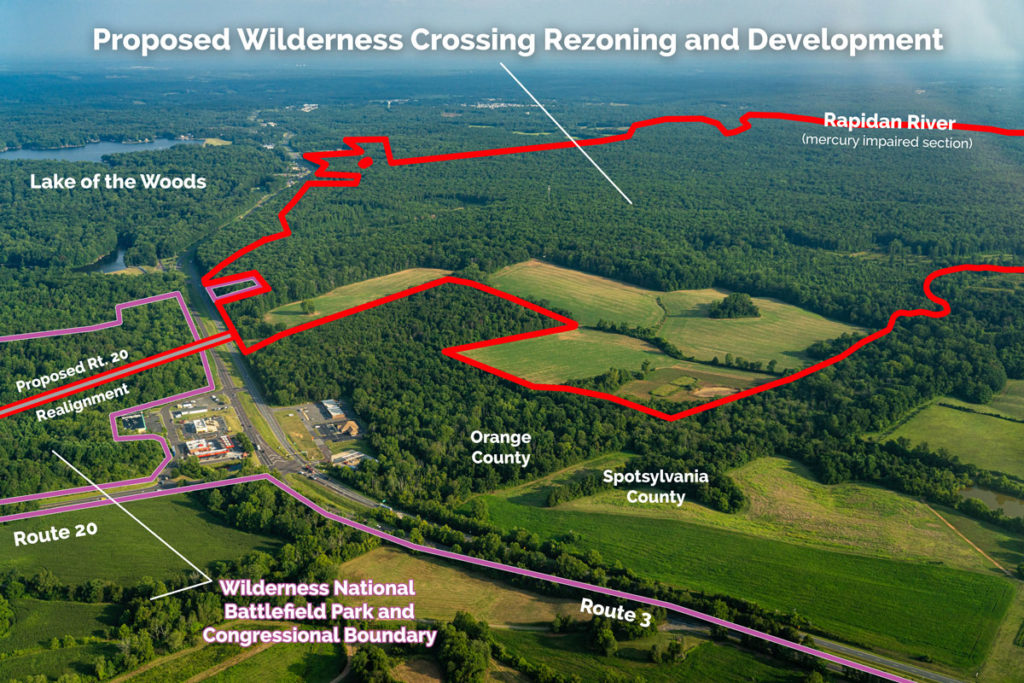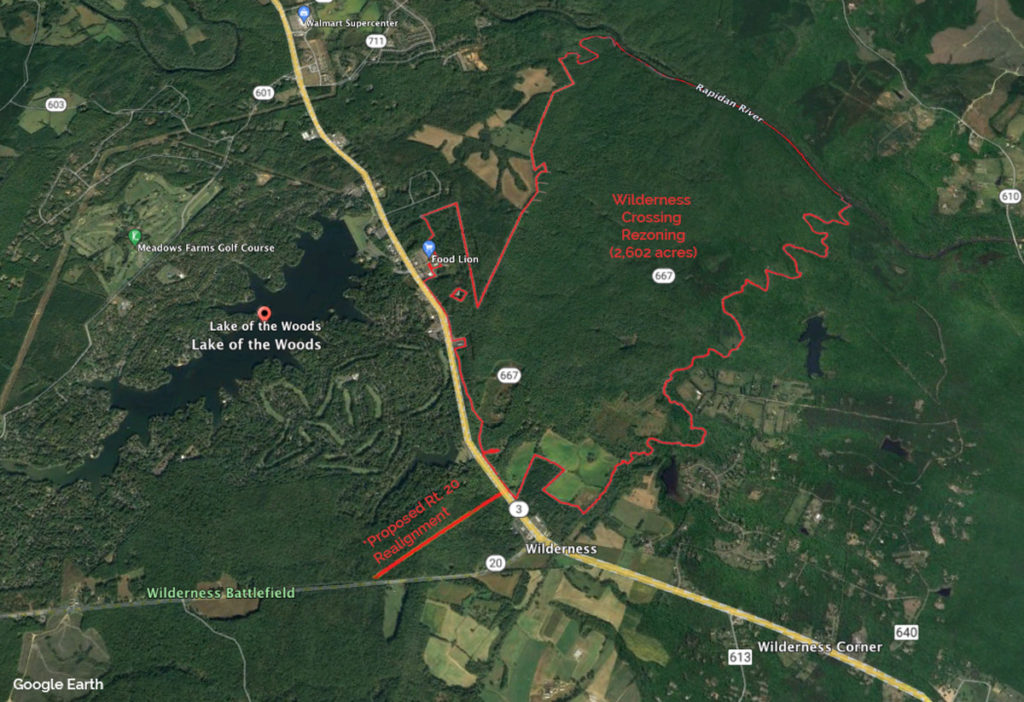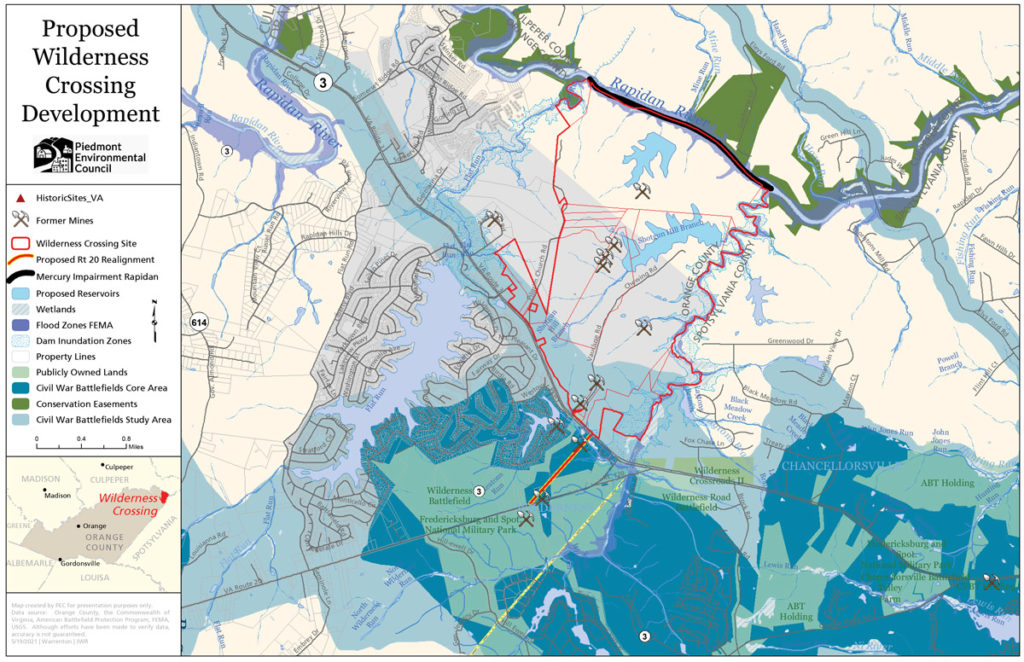
Orange County is considering an enormous, 2,602-acre development and rezoning proposal, called Wilderness Crossing, within the Germanna-Wilderness Area (GWA) in northeastern Orange, bordering Culpeper and Spotsylvania counties. If approved, Wilderness Crossing would be the largest land rezoning in the county’s history and could:
- Double the county’s overall population and number of existing homes;
- Lead to significantly increased county-wide taxes;
- Stress existing public services (e.g., schools, transportation, water/sewer);
- Disturb onsite soils that may contain mercury and contaminate drinking water;
- Reduce open space, wildlife habitat, and riparian buffers along the Rapidan River; and
- Do nothing to provide affordable housing options.
We ask all Orange County residents to pay close attention to the Wilderness Crossing proposal and make a plan to share comments during the upcoming public hearing.
On Thursday, Sept. 16, an informational worksession was held by the Orange County Planning Commission in which the planning commission directed county staff to explain to the applicant that the proffers are totally inadequate and to cancel the tentative Oct. 7 public hearing for lack of sufficient information. Watch the recording.
It is now unclear when the public hearing will occur (although it would be confirmed at least two weeks in advance and given notice in local newspapers), or when the applicant will come back with a revised proposal. We’ll link to the necessary information once it becomes available.
You can share your thoughts ahead of time by submitting written comments to the Planning Commission at zoning@orangecountyva.gov or Board of Supervisors via Chief Deputy Clerk Alyson Simpson at asimpson@orangecountyva.gov with the subject line “REZ 21-02 Wilderness Crossing.” Please also copy your representative on the Board of Supervisors (find your district), to ensure they also know how you feel. Written comments may also be submitted by mail to Attn: Alyson Simpson, P. O. Box 111, Orange, Virginia 22960.
About the proposal

Wilderness Crossing is an enormous, 2,602-acre development (about the size of Lake of the Woods) and rezoning proposal along the Rt. 3 corridor. It is bordered by Rt. 3, Culpeper and Spotsylvania counties, and two miles of the Rapidan River. The majority of the site right now is zoned agriculture, with some zoning for commercial, industrial, and residential allowing for approximately 1,114 residential units.
The developer, KEG Associates III, is asking that the entire property be rezoned to Planned Development-Mixed Use (PDM), which requires a prescriptive mix of commercial, office, light industrial development, open space, and as many as six to 12 residential units per acre—which translates to 7,807 to 20,299 residential units. Based on Orange’s average of 2.36 people per household, those units could support up to 47,906 people. For reference, in 2019, Orange County’s 15,382 residential units housed a total population of 36,254. Lake of the Woods, a nearby residential development, is similar in acreage but lacks the scale of residential development and commercial components requested in the Wilderness Crossing proposal.
Normally, a proposed development plan includes hard numbers for residential and commercial structures; however, the Wilderness Crossing proposal does not. Nor does it include a build-out schedule over its proposed 30 years. Rather, the developer has only verbally and vaguely said they envision about 5,000 residential units and 1.6 million square feet of commercial space, letting market forces determine the ultimate build-out. Both the fiscal impact analysis and traffic impact analysis for Wilderness Crossing are based on arbitrary numbers of residential units within arbitrary timeframes that may or may not resemble the actual build-out.
While the developer has requested mixed-use zoning, their proposal shows a rather segregated mix of development types: commercial development intermixed with townhomes and apartments along Route 3, large-lot single-family homes that consume an overwhelming majority of the site, and fragmented open space scattered throughout residential development. The overall development plan emphasizes large lot, riverfront residential properties, with selective access to onsite trails and little connectivity throughout the development. It also appears to lack protections for riparian buffers and natural habitat along the Rapidan River.
If approved, Wilderness Crossing would be the largest rezoning in the county’s history, and one of the largest in our entire region at this time, with the potential to more than double Orange County’s entire population. View our StoryMap >>
Why we’re concerned

Wilderness Crossing’s massive scale poses a variety of significant risks to county residents and resources. PEC is concerned about:
1. Lack of specificity within the developer’s plans, combined with the flexible PDM zoning, could lead to a very different outcome than county leaders and residents expect:
- Without expressly stating how much residential and commercial development is planned in writing within the application, along with annual build-out phases for the development, the fiscal impacts of Wilderness Crossing cannot be calculated. Furthermore, development could occur at an unrestricted pace, posing threats to existing public infrastructure (e.g., schools, roads, water/sewer) and creating immense fiscal impacts for Orange County.
- Too much residential development without a balance of sufficient commercial development (with its tax revenue) could create a cost burden for Orange County.
- The lack of specificity in the current proposal is a red flag for bait-and-switch development, which happens when a developer purchases land or asks for a rezoning without any guarantee that they will end up building what they say they will build.
1) The Bait: A developer buys land with limited zoning at a low cost, then gets approval for a rezoning with more development rights, often by promising various benefits to the community, such as reservoirs, waterparks, land for schools.
2) The Switch: At some point after the rezoning is approved, the developer sells the now-more-valuable land at a profit, without ever building their proposed development or promises. Making matters worse, this sets up a new developer to come in and use the new zoning to build something completely different than the elected officials and community approved. When this happens, the community suffers.
2. Tax implications for county residents as a whole:
Orange County’s tax structure requires that all residents collectively pay for public infrastructure, such as schools, roads, and water/sewer. Because the area where Wilderness Crossing would be has a limited amount of existing public infrastructure, the mammoth size of the development would require the construction of new schools, roads, and water/sewer utilities.
The developers have proffered, or offered, land for a new school site and has implied donation of land for a reservoir, but have not offered anything else that would cover their high costs for design, planning, construction and infrastructure. If the taxes generated by the proposed development are not high enough to pay for the necessary infrastructure, these costs will fall upon the county-wide tax base.
- Public school system impacts: KEG Associates III’s Fiscal Impact Analysis calculates public school impacts based on 1,000 residential units being constructed by 2030; however, as discussed above, the developer has failed to include both a clear maximum number of residential units and an annual phasing schedule for residential development. In addition, the developers have verbally stated 5,000 units while the requested zoning would allow for 20,299 units. Without these details, there is no way to accurately predict the impact that the Wilderness Crossing development would have on the school system. There is quite a difference in the fiscal impacts associated with 5,000 residential units and 20,299 residential units.
- Traffic impacts: The developers’ Traffic Impact Analysis for Wilderness Crossing was based on 4,150 residential units by 2050; however, as discussed above, PDM zoning could allow for up to 20,299 residential units, which would have a much greater impact on the county’s road network. Accurate traffic impacts are vital to ensuring that proposed developments do not overcrowd the public road system.
3. Public health and water quality impacts resulting from mercury contamination related to historic gold mining activities:
During Virginia’s gold mining era from 1804 to 1937, the Wilderness Crossing property was the site of at least 27 gold mining operations, including nine shaft mines and 18 pit mines according to the Virginia Department of Mines, Minerals, and Energy (DMME). The shaft mines reach depths of roughly 100 feet below ground surface and extend 300-400 feet in length. The pit mines range in size from a kiddie pool to entire hillsides.
Gold mining practices in Virginia historically used mercury to extract gold from the Gold-Pyrite Belt of the Northern Piedmont. Mercury is considered by the World Health Organization (WHO) to be one of the top 10 chemicals or groups of chemicals of major public health concern, with possible toxic effects on the nervous, digestive and immune systems, and on lungs, kidneys, skin and eyes. Learn more about the history of gold mining in Orange County by watching this video from the Orange County Historical Society >>
Virginia’s Department of Environmental Quality and the Environmental Protection Agency have deemed the adjacent section of Rapidan River impaired due to mercury in fish tissue and has prohibited the consumption of fish from this section of the Rapidan. And yet, this development would be built around one of two potential reservoirs that appear in the county’s comprehensive plan—a reservoir that would rely upon the mercury impaired Rapidan River to supply drinking water.
Development of the Wilderness Crossing property could result in additional mercury contamination. Disruption of onsite soil for grading and construction of Wilderness Crossing could release mercury toxins into the new residential development areas, the proposed reservoir, the Rapidan River, and local groundwater.
If Orange County continues pushing for suburban and urban development in the Germanna-Wilderness Area, the county needs to better understand the risks associated with onsite gold mining impacts and the Rapidan River’s mercury impairment. Learn more about mercury impairment at Wilderness Crossing on the EPA’s How’s My Waterway webpage.
4. Realignment of Route 20 through Wilderness Battlefield National Park:
The Route 20 and Route 3 interchange is approximately 0.25 miles southeast of the proposed Wilderness Crossing site. As such, the developer has proposed a rerouting of Route 20 to realign the road so that it would intersect with Route 3 at the central point of Wilderness Crossing. A realignment of this nature would require large land disturbance to the Wilderness Battlefield National Park and approximately one mile of new road construction.
5. Fragmented open space that would be detrimental to wildlife and water quality:
Most of Wilderness Crossing’s 2,602 acres are defined by Virginia as vital to its ConserveVirginia priorities. Although the developers have verbally said that 50% of the area would be open space, their current site layout shows fragmented open space throughout the development, which is currently mostly contiguous and intact forest and agricultural land. This would have negative impacts on wildlife habitat and streamside buffers along the two-mile stretch of the Rapidan River that borders the property.
6. Lack of community cohesion and walkability:
One of the GWA’s founding principles is to create: “A Place to Live, Work, and Play with a higher standard of design and development which is a self-contained, complete community…”. However, under the current conceptual design, Wilderness Crossing’s residential development would be scattered throughout the 2,602-acre site with limited bike and pedestrian connectivity, leaving many Wilderness Crossing residents with a two-plus-mile walk to reach the town center, future school site, park, post office, and commercial/industrial development along Route 3. The proposed onsite trails appear to have limited public access, with a focus on internal connectivity as opposed to creating connections to the existing community.
7. Affordability and contribution to affordable housing needs:
The lack of specificity within the Wilderness Crossing proposal, and the developers desire to let market forces determine its build-out, suggests that it would likely target market rate housing, to the exclusion of inclusive housing options.
According to the proposal, “townhomes will start around $280,000 and single family homes around $310,000…and larger lot single family homes prices will range from $365,000 to over $500,000.” With Orange County’s median home value being $244,400 between 2015 and 2019, this proposal hardly provides housing that will be accessible for public servants (e.g., first responders, teachers, nurses etc.) and those making less than the average median income of $71,548.
Our recommendations
So far, we’ve given you a long list of problems, risks, and gaps in the current Wilderness Crossing proposal. It’s time to think of how to start addressing the issues on that list:
- Conduct an environmental review for mercury contamination: The Virginia Dept. of Mines, Minerals, and Energy (DMME) has documented at least 27 historic gold mines on site. The Virginia Dept. of Environmental Quality (DEQ) and the EPA have listed this section of the Rapidan River as impaired from mercury. Therefore, PEC recommends that the applicant be required to fully evaluate the site for mercury and other contaminants associated with historic gold mining practices. This evaluation should be thorough, complete with soil samples, and provide evidence that development of this site would not result in potential onsite or offsite impacts to public health or the environment. Historic gold mining and the contamination left behind is an issue in many areas of the commonwealth. Beyond any discussion related to Wilderness Crossing, we support a more comprehensive statewide effort involving DMME, DEQ, and the Virginia Department of Health (VDH), to assess the ongoing damage to the environment and public health associated with past mining operations.
- Onsite reservoir study: Limited reservoir studies have been completed to determine the feasibility of an onsite reservoir due to the mercury impacts of historic gold mining. PEC recommends that the county seriously consider how the history of gold mining in this region may impact general development, public health and future water supply prior to any determination of potential reservoir location(s).
- Specified residential minimums/maximums and commercial minimum/maximums: To make clear the fiscal impacts of the application, while ensuring business certainty for the developer, community and Orange County residents, PEC recommends that residential unit maximums and the minimum square footage of commercial development be included within the application. Without express description, the developer would have a lot of discretion to significantly alter the development build-out from what the community and county leadership approved.
- Revise Impact Estimates: Once specific numbers are confirmed for the amount of residential and commercial development, the county should request updated, accurate analyses to best understand Wilderness Crossing’s impacts on taxes, infrastructure needs (water and sewer), and traffic.
- Cluster zoning: The project should cluster the development in such a way as to reduce the fragmentation of forests and open spaces and avoid impacting wildlife habitat and riparian buffers along the two mile stretch of the Rapidan River. Additional benefits of clustering the development within the site: less infrastructure (including roads and public utilities) and therefore less cost to taxpayers, and improved walkability and community cohesion.
- Protect Wilderness National Battlefield Park: The irreplaceable value of Wilderness National Battlefield Park requires any intersection improvements to be judged against impacts to this hallowed ground. A rerouting of Route 20 and a new intersection would cause real and irreparable harm to this national treasure.
- Affordable housing: In addition to greater specificity in residential and commercial build-out of Wilderness Crossing, PEC recommends that the rezoning application include 20% affordable housing options for rental and for-sale units, which is consistent with statewide best practices.
What you can do
There is no tentative date for a public hearing yet. You can still share your concerns with the county:
Email your comments to the Planning Commission at zoning@orangecountyva.gov or Board of Supervisors at asimpson@orangecountyva.gov with the subject line “REZ 21-02 Wilderness Crossing.” Please also copy your representative on the Board of Supervisors (find your district), to ensure they also know how you feel.
Public engagement is the most critical piece of community planning, to ensure local elected officials make decisions that are consistent with the interests and desires of its citizenry. We ask and encourage you to learn all you can about the Wilderness Crossing proposal, plan to attend the public hearing, and share your thoughts and concerns. We plan to share more information with you as it becomes available. In the meantime, you can also learn more at the links below.
More information
- Wilderness Crossing Application Information
- Wilderness Battlefield Gateway Study
- Orange County Review: Wilderness Crossing: 2,602-acre mixed-use development proposed in eastern Orange County
- Orange County Review: What is the Greater Wilderness Area Plan?
Questions? Please contact PEC’s Director of State Policy, Dan Holmes at dholmes@pecva.org.
